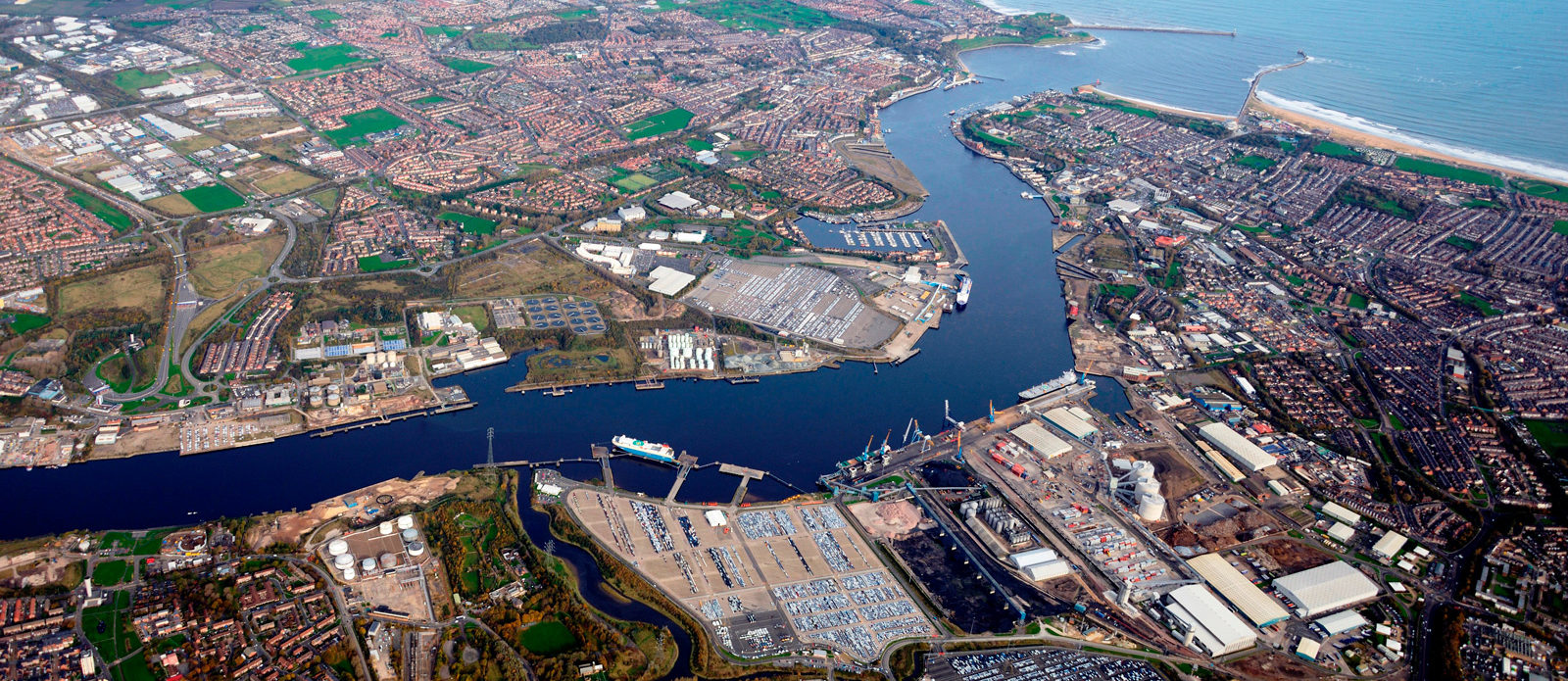Never has there been a more important time for the Offshore Wind sector. The North East is at the centre of the quest for net zero – and it’s one of few places which boasts all the ingredients to transform its rapidly growing offshore wind cluster into a global powerhouse.
Some of these ingredients are woven into the fabric of the region’s industrial heritage, while others have been nurtured through wider infrastructure, supply chains and public sector support. The North East is blessed with four major rivers which provide excellent exporting capabilities and access to global markets.
Ports at Blyth, Hartlepool, Middlesbrough, Sunderland, Teesport and Tyne, each have their own outstanding transport and logistics infrastructure. They also offer their own strengths and sites for the manufacturing, construction, and deployment of offshore wind turbines and associated large-scale components.
All these coastal hubs are very well placed to access major offshore wind developments taking shape in the North Sea basin. Transformative projects at Hornsea and the Firth of Forth are within reach of the region’s ports – with 80% of all the UK’s wind farms reachable within 24-hour vessel time.
Dogger Bank which will be the world’s largest Offshore Wind Farm when complete, will be capable of powering six million homes – and is only 80 miles off the North East coast. All facets of the Offshore Wind supply chain can be found in the region, from blade manufacturing to subsea infrastructure, transition pieces, and operations and maintenance.
Invest North East England, Director, Guy Currey said:
“Beyond our region, there is growing awareness and admiration for what we have here. The North East is the centre of the UK’s green energy revolution. As we look to the future of offshore wind, it’s important to reflect on our strengths, which are of course bolstered by our fantastic location.
“We’re adjacent to the North Sea. We have Dogger Bank Wind Farm – nothing less than the largest wind farm in the world – on our doorstep. Sites off the coast of Yorkshire and Scotland are also close at hand.
“So much of what we can offer offshore renewables is grounded in years and years of engineering expertise and supply chains built on the back of the oil and gas industry. That’s a strong message to take out to a world where our reputation increasingly precedes us. Globally, as the need, legislation, and ambition for net zero mounts, awareness of the North East’s capabilities grow in sync. The world knows it needs to change fast – the North East is ready.”
Two international airports, arterial links to the nation’s main road and rail networks, and the largest rapid transit system outside of London in the Tyne and Wear metro allow our workforces to move smoothly throughout both our region and the UK. The region also has a healthy pipeline of talent at five universities alongside specialist training providers providing bespoke offshore training facilities.
Energi Coast – the North East’s Offshore Wind Cluster – is also a key cog in the machine of the North East’s Offshore Wind network. Nurtured and developed by NOF, it is made up of more than 30 vital regional businesses and stakeholder organisations with a key role to play in the region’s Offshore Wind ambitions. It helps showcase the region as a hub for serving both the international and burgeoning UK markets – and promotes the North East’s vast supply chain through its group of Developers, Ports, Academic bodies, Innovation and Research organisations and its two Local Enterprise Partnerships.
The region also hosts a highly experienced, skilled, and passionate workforce steeped in engineering and manufacturing. This is borne out in the numbers; the North East employs more than 69,000 advanced manufacturing workers out of a total of more than 116,000 manufacturing employees.
High-quality industrial development sites are plentiful – and all are within easy access of deep-water ports with direct quayside access. These include Tyne Clean Energy Park, Energy Central, Trinity Rail, Road and Sea Enterprise Zone, Teesside Freeport sites and the UK’s largest industrial zone – Teesworks. The financial incentives of many of these sites, including and tax and customs benefits, bolster capital allowances for vital investment in plant and machinery.
Teesside Freeport, the UK’s largest and first operational Freeport, will offer one of the biggest low tax customs zones in the nation. Covering 4,500 acres the freeport covers a vast area with a multitude of different industries, including Wilton International – the UK’s biggest chemical complex, Redcar Bulk Terminal, Port of Middlesbrough, Port of Hartlepool, Teesport, Teesside International Airport, LV Logistics, and Teesworks – the largest development site in Europe. Benefits from streamlined planning processes on top of tax and customs incentives make Teesside Freeport well-placed for further growth of the Offshore Wind sector.
Construction is underway for SeAH Wind Ltd and its £400million Offshore Wind monopile manufacturing facility to sit alongside the £107million heavy lift South Bank Quay on the River Tees. A total of 750 direct jobs in construction and 1,500 jobs in the supply chain are in the offing. The quay will provide instant access to more than 500 acres of manufacturing, storage and mobilisation facilities – making it ideal for offshore wind manufacturing.
Chris Beck, Group Director of Clean Growth and Innovation at the Tees Valley Combined Authority, said:
“We’re already seeing real examples of what we’re bringing to the Offshore Wind sector. Our workforce has been steeped in advanced manufacturing and engineering for generations, and the world is now sitting up and taking notice of both the scale and range of projects we now have.
“The arrival of SeAH, major infrastructure works taking place at South Bank Quay, and opportunities the Teesside Freeport offers for our supply chains are evidence the building blocks are in place to make the North East a true global powerhouse in green energy.”
Equinor and SSE Renewables are also building a new O&M base at the Port of Tyne in South Tyneside, to support the vast Dogger Bank project – with the potential to create more than 400 jobs.
Other key sites on the Tyne include the Neptune Energy Park, Swans Offshore Energy Park, and Hadrian Yard, where Smulders Projects UK will shortly be manufacturing transition pieces for wind turbines. The Port of Blyth – home to the world’s first offshore wind farm – is now the base for flagship technology innovation and research centre – the Offshore Renewable Energy Catapult. Nearby construction has commenced for JDR Cable Systems new £130m subsea cable manufacturing plant.
Looking to the bourgeoning supply chain, North East businesses are securing contracts at some of the world’s largest wind farms. South Tyneside based Metec UK was awarded a contract to install a 30-year cathodic protection system for what is set to be the UK’s largest offshore wind tower factory in the Cromarty Firth, Scotland, earlier this year.
In addition, the region’s rich digital sector is supporting the offshore sector in new processes and technologies with companies such as VRAI and AIS Survivex to the fore.
Research published by the Offshore Wind Industry Council (OWIC) in 2021 shows the number of people working in direct and indirect jobs in the UK’s world-leading offshore wind industry is set to rise significantly from 26,000 currently to more than 69,800 by 2026. The sector employs 5,740 people and contributed more than £400million GVA to the UK economy in 2020 – up 1.5% on the previous year, compared to a 1.1% rise nationally. This shows the real potential the region has to deliver clean energy projects.
The North East is home to top quality Research and Technology organisations including Offshore Renewable Energy Catapult, CPI, TWI, The Materials Processing Institute, and Tyne Pressure Testing. The five universities – Newcastle, Durham, Teesside, Sunderland, and Northumbria also provide unparalleled expertise and support when it comes to the development of clean technologies.
To find out more about locating your offshore business in North East England please contact
- Guy Currey, Director, Invest North East England – guy.currey@inee.co.uk
- Chris Beck, Chris Beck, Group Director of Clean Growth and Innovation at the Tees Valley Combined Authority – Chris.Beck@teesvalley-ca.gov.uk
For further information on the offshore wind sector in North East England, please visit www.energygatewaynortheast.co.uk or www.teessidefreeport.com


